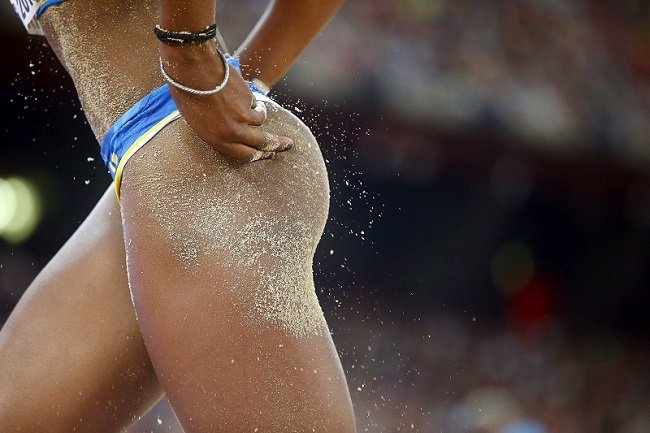
Khaddi Sagnia, World Athletics Championships in 2015 - ©Diego Azubel / EPA
Humans have really large butts. Your cat or dog, by contrast, has a very tiny bottom.
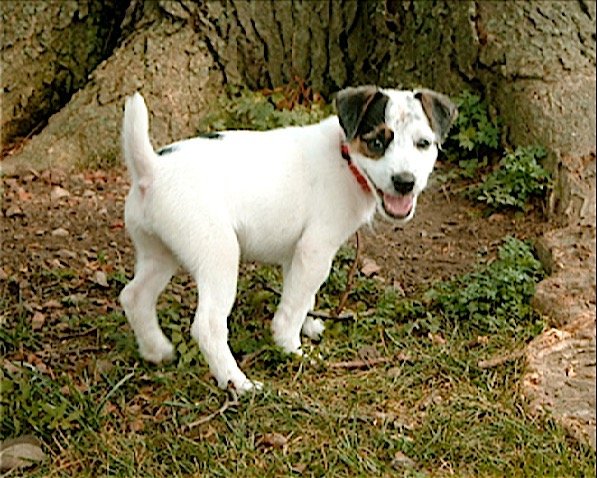
Dogs and cats have tiny bottoms
Chances are you’ve never stopped to think about how unique your own derriere is. Primate species are unique in having distinctive buttock anatomy—our buttocks allow us to sit upright without resting our weight on our feet, the way our pets do. Human buttocks, which are particularly muscular and well-developed, empower us to be bipedal, and propel us forward in walking and running. Even if you’re thinking, ‘I don’t have much of a butt at all,’ there’s no comparison between your behind—which has great potential!—and an ape's.
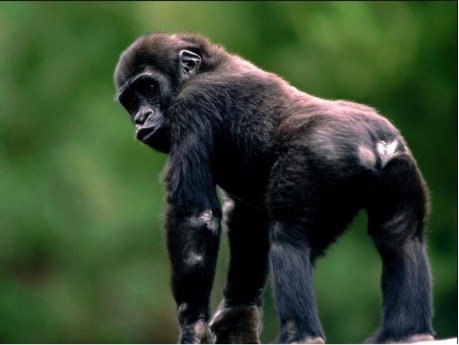
Our primate cousins have similar, but much less-developed gluteal muscles than we do.
Older scientific sources often cite walking as the reason for our large buttocks. Gluteus maximus and medius are important in stabilizing the pelvis and trunk—they keep us from tipping over when we lean into a brisk walk, as well as during older caveman-style activities like throwing and clubbing. (Marzke)
We also know that the gluteal muscles are key for running. The Olympic track and field athletes you’ve been watching in the last few weeks have strong glutes not only for balance, but also to power their bodies across the track, over hurdles, and through the air. All that energy and propulsion comes from the powerhouse of the lower body—the buttocks.
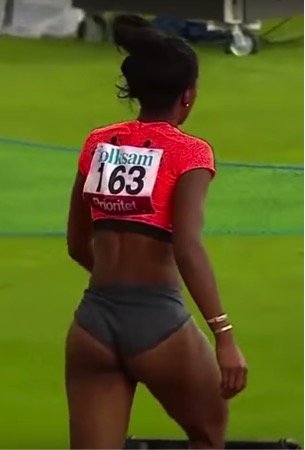
Khaddi Sagnia, long jumper, with well-developed glutes, walking down the track.
I believe that top athletes like Khaddi Sagnia dominate their sports not just from doing reps at the gym and on the field, but also from doing ‘Downtime Training®’—that is, practicing everyday tasks with excellent, natural form. When the glutes are strongly activated in walking, every step is a rep. This is a good example of Downtime Training. As we can clearly see in Khaddi’s example, even her breezy walk down the track prepares her glutes for running and jumping.
Here you can see a video of Swedish long-jumper Khaddi Sagnia, who provides a beautiful example of well developed, active glutes.
Does an ideal walk select for athletic excellence, or does athletic training result in an excellent stride? I believe the two support each other. Someone who already has well-developed muscles from an excellent gait is more likely to excel at sports that involve running, jumping, and lunging; conversely, vigorous use of the glute pack and posterior chain in a sport will predispose a person to have a stronger, better co-ordinated stride. I believe that athletes competing at the Olympic level experience an upward spiral of healthy movement patterns reinforcing athletic excellence, which in turn reinforces healthy movement patterns.
Some recent scientific studies, citing electromyographic (EMG) experiments, have concluded that the gluteus maximus muscle is minimally active in many activities such as walking or climbing stairs, while being highly active during running. In an interview published in Nature about research on how humans evolved to be distance runners, Daniel Lieberman of Harvard claims that running seems to be the only reason that we have prominent buttocks. He has measured the activity of gluteus maximus in volunteers during a walk and a jog and says:
"When they walk their glutes barely fire up. But when they run it goes like billy-o." (Hopkin)
I believe that Lieberman’s finding reflects degenerate modern industrial gait more than it does an evolutionary truth about our species.
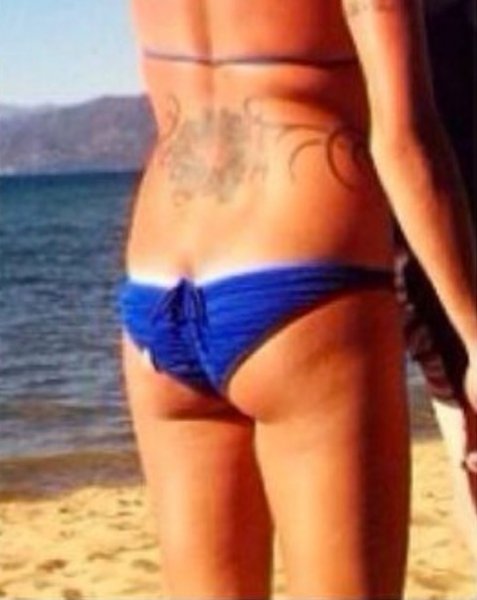
Modern-day underdeveloped butt
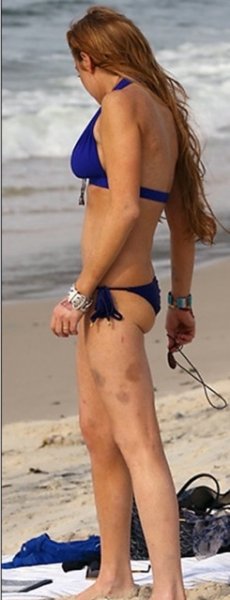
Lack of glute development accompanied by thoracic kyphosis
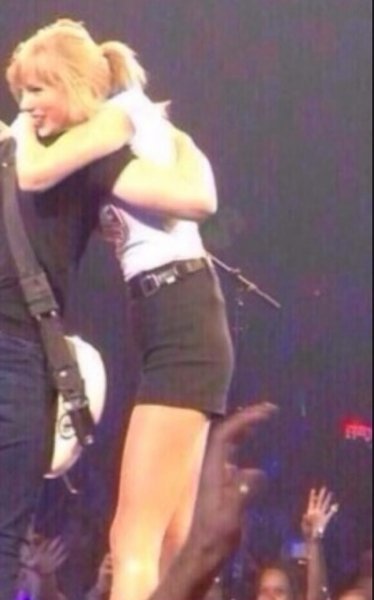
Our celebrities are not exempt from the under-developed glute phenomenon, as Taylor Swift demonstrates here.
As we see clearly in the example of Khaddi Sagnia, or other athletes, or indigenous people, or young children, the glutes are in fact actively used in walking and climbing. It’s only in very recent times that we find appreciable numbers of people who barely fire their glutes while walking.
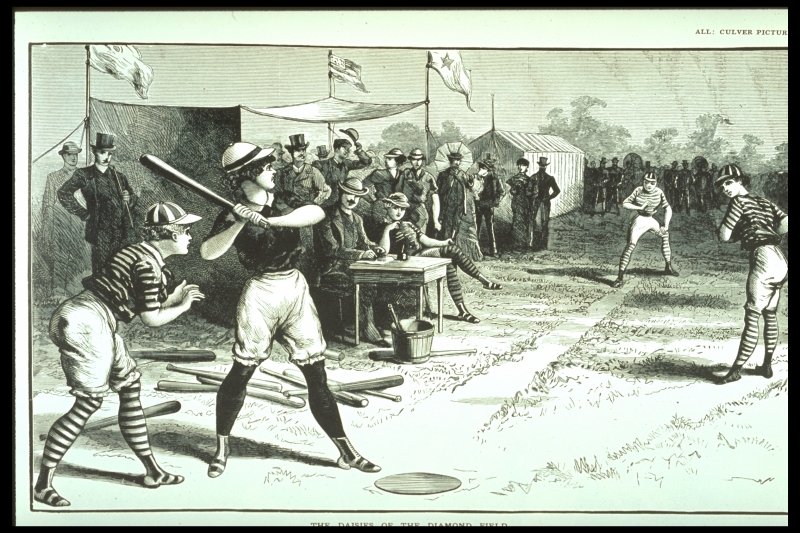
Athletes, like the baseball players above, usually have well-developed gluteal muscles.
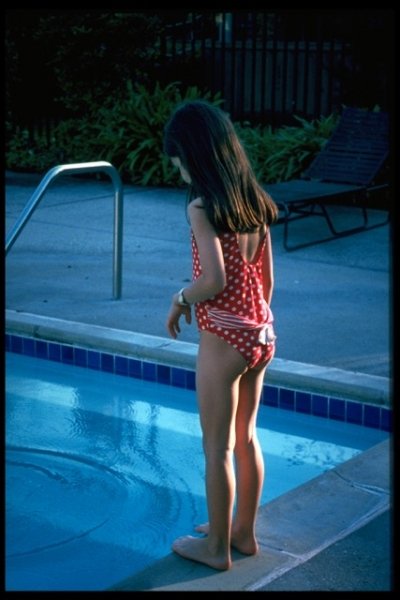
Maya White, Esther's oldest daughter, showing the typically toned glutes shared by young children.
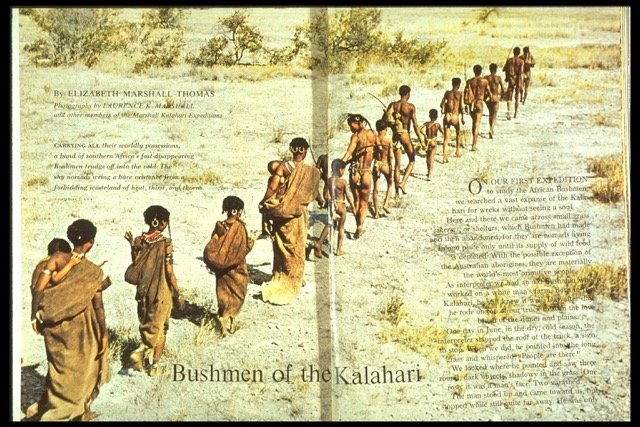
The San indigenous people of the Kalahari, show well-toned glutes from walking and running with primal form.
I teach my students to glidewalk, an ancestral walking form whose mainstay is the activation of the gluteal pack of muscles. Try standing before a table or desk. Turn your right foot outwards while leaning your torso and pelvis forward. Now lift your right leg out behind you (you can hold the edge of the table for support). Your entire gluteal pack will contract – the hamstrings, gluteus maximus and gluteus medius. This is the action you want to find in every step you take.
There are other muscles that are part and parcel of a healthy gait – the calf muscles help launch the rear leg forward to its destination; the muscles on the underside of the foot help grip and grab contours on the earth – and we share these actions with other animal species. But buttock action is special – it marks us as a species, and as bipedal creatures – and it behooves us to use our butts more than most of us currently do.
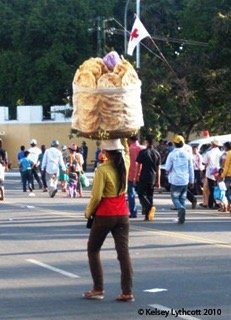
A woman glidewalking in Cambodia
Scientists are right in describing the marked use of the glutes in running, and it is clear their current size is tied to an evolutionary propensity for distance running. Yet it seems unlikely that our ancestors, when they first came out of the trees, hit the ground running. Bipedal walking had to be a predecessor to running while our ancestors mastered balance and being upright. I believe prominently sized butts first developed when our ancestors began to walk upright, and that we want to follow the example of the Olympic athletes in engaging our glutes, not just when we run, but also when we walk. This form of constant training will reinforce healthy posture, as well as strength. And if you’re really lucky, maybe you too will soon be cruising around sporting Olympic hot pants like Khaddi’s. Let us know when that happens - we’ll send our videographer over so we can all enjoy the moment!
Join us in an upcoming Free Workshop (online or in person).
Find a Foundations Course in your area to get the full training on the Gokhale Method!
We also offer in person or online Initial Consultations with any of our qualified Gokhale Method teachers.
References
Bramble, Dennis M., and Daniel E. Lieberman. "Endurance Running and the Evolution of Homo." Nature 432.7015 (2004): 345-52. Web.
Fischer, Frederick J., and S. J. Houtz. "Evaluation of the Function of the Gluteus Maximus Muscle." American Journal of Physical Medicine 47.4 (1968): 182-91. PubMed. Web.
Hopkin, Michael. "Distance Running 'shaped Human Evolution'." Nature.com. Nature Publishing Group, 17 Nov. 2004. Web. 25 Aug. 2016. <http://www.nature.com/news/2004/041115/full/news041115-9.html>.
Lieberman, D. E. "The Human Gluteus Maximus and Its Role in Running."Journal of Experimental Biology 209.11 (2006): 2143-155. Web.
Marzke, Mary W., Julie M. Longhill, and Stanley A. Rasmussen. "Gluteus Maximus Muscle Function and the Origin of Hominid Bipedality." Am. J. Phys. Anthropol. American Journal of Physical Anthropology 77.4 (1988): 519-28. Web.


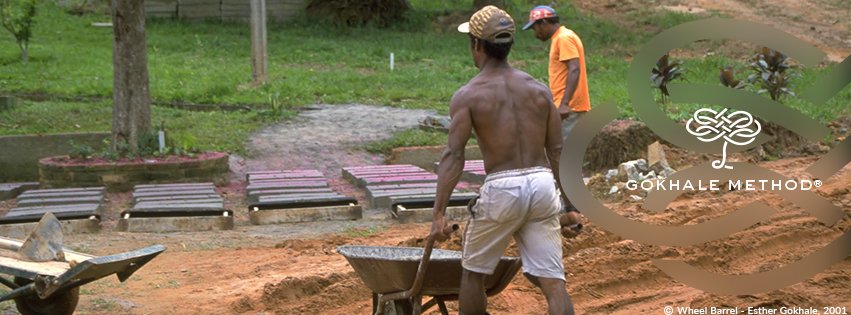
Comments
A great article, thanks
A great article, thanks Esther!
Lovely to hear from you one
Lovely to hear from you one day after working with you! This is great timing for reinforcing your shifts in gait - so glad you read it.
I am currently dealing with a
I am currently dealing with a very painful case of Piriformis Syndrome. Walking tends to make it worse. I have not been able to find a PT understands this condition. Glide walking is very difficult and painful for me. Any tips?
Hi there, It's surprising to
Hi there,
It's surprising to me that you haven't been able to find a PT well-versed in pyriformis syndrome - this is usually very much on a PT's radar. What a PT doesn't often do is spend some hours with you to change your gait, while takng care not to trigger your sciatic nerve. This is something our teachers can help you with. Look for a teacher in your location or consider traveling to take an Intensive Gokhale Method course in a convenient city.
You will learn to never push through pain, even if there is a theory that is compelling and a measure that works for most people. Everyone is an individual, and individual variations in nerve pathways abound - pain is a very handy guide in charting your course towards an improved structure, gait, etc.
If walking hurts, that's a bummer. Of course, not walking at all has many downsides and is not a longterm solution. My guess and hope is that you can find a shift in your pelvic and hip architecture that allows you to walk painlessly, at first with small steps and not very long, and later more normally. This is multi-layered and not easy to describe on a blog. Seek out help from one of our teachers while simlutaneously consulting someone from mainstream medicine to ensure you are proceeding in a safe and sound way.
I wish I could describe
I wish I could describe exactly how I did it, but I have dealt with the same condition and learned to minimize and almost eliminate it through simply moving differently. I have a theory that my method is similar to the Gokhale Method but since my body learned it, not me, I have a hard time describing the changes I've made. What I can say is that strengthening those muscles and learning to stretch, sit, stand and walk correctly has taken me out of chronic pain. So don't give up!
I had piriformis syndrome for
I had piriformis syndrome for years but did not know what it was until recently. I found a deep tissue massage therapist who was able to relieve my symptoms in three sessions. In case you are in the Seattle area I can recommend Amber Myers of Seattle Massage Pro. I plan to take the Gokhale course as soon as there is one close enough, but for now I am delighted to walk pain free!
Go see a Chiropractor.
Go see a Chiropractor. Especially one that is familiar with sacro-occipital technique (SOT).
Thank you for this wonderful
Thank you for this wonderful blog and the video--- more inspiration to keep me committed to the daily habit changes I'm practicing.
We'd love for you to be
We'd love for you to be surrounded with good examples that inspire healhty posture all day every day. Until then, we're doing what we can to support all of you!
I have an adjustable desk at
I have an adjustable desk at work so I can stand and sit as desired which is a novelty at my job. I find it to be absolutely essential to my long term health as I have degenerative disk compression (C5/C6) which flares up when I sit for too long. Although I do stand for several hours per day (until I feel it in my lower back), I wonder if you have suggestions for standing 'correctly' at the desk.
Sit-stand desks are great
Sit-stand desks are great because it is best to have variety in your positions at work. What's equally importnat is to do each position well. It sounds like your standing poistion can use some improvement. Chapter 6 on 8 Steps to a Pain-Free Back is all about how to do this. So is one of the segments of my DVD available here through the website. The best way by far to learn anything kinesthetic is with a qualified teacher - with our expanded team of teachers, we're now in a good position to teach you almost anywhere you are.
I took the Gokhale week long
I took the Gokhale week long class several years ago and learned glide walking. When I tried it at home, I developed pain in both feet, to the point that I had to wear a walking boot for several weeks to relieve the pain. I stopped glide walking for about a year then tried again and the foot pain returned, again I had to wear a walking boot for about a month. On a positive note, my lower back and groin pain subsided but the foot pain made it impossible for me to continue glide walking. Have you heard of this before and if so, what am I doing wrong?
Ouch! This is not usual at
Ouch! This is not usual at all.
1. It's one of our most important directions to NEVER push through pain. Pain is a sophisticated mechanism that evolved to tell you to do something differently. It's important to listen to it! So you needed to stop as soon as you felt any pain - in the first round and the second.
2. Not everyone learns these techniques equally easily. Most people leave the six-lesson course with a toolkit that allows them to continue to make progress after. We recommend doing some maintenance and course-correction work beyond the course - there are a couple of options available for this - in-person group and one-on-one classes, and our Online University. For some, these offerings are critical for honing the basics; for all, they help to not backslide and instead make progress. Online University, in addition to a large library of useful videos to help you review and hone your learning, also includes twice monthly Live Chats with me. You could send photos and / or videos of yourself trying to glidewalk and I would critique them in the group Live Chat (which includes video, audio, text, etc., features). In this way, for the price of less than one private session, you can get customized feedback from me, other teachers, and other alumni of our course, twice a month. Many people have found this very helpful.
3. I took a look at your Before and After photos and I believe that six lessons did not quite do the job for the shifts we like to see. You seem to be trying very hard to have good posture in your After pictures - this work is not done through heroic efforts - it's more about relaxation, stacking bones, appropriate strengthening, and waiting patiently for the shifts to happen. It's not about recruiting one set of muscles to fight another set of muscles. To me, this is good news because even if these concepts didn't entirely land in 6 lessons, they are likely to with a few review lessons.
Sorry your trajectory has been so spectacularly untoward. I' also disturbed that this is the first we are hearing about it. We will have to figure out how to invite more communication earlier when there is a problem. The best place to begin is with your teacher; if that doesn't work, then we need to hear. This blog is probably not the best place to be discussing personal history and you are welcome to delete your post if you prefer. I'm hoping to meet you in one of the Live Chats soon - if you can't find how to do this, contact our customer support and they can explain further details.
I appreciate the reply and I
I appreciate the reply and I'll look into the Online University.
Thanks.
I woke up thinking about this
I woke up thinking about this (it's a pretty unusual and disturbing occurrence). I noted in your history that you have had "Age 16: Tore ACL & miniscus in L knee, 2 surgeries, one an ACL reconstruction" and that your exercise routine was "non-existant due to back pain." I'm glad your back is better from the course and that you can now (I hope) exercise, but I'm wondering whether due to your previous inactivity and trauma, your Achilles tendons may have been particularly tight. In that case, it may stretch your Achilles tendons too much to leave your rear heel on the ground well into your stride. You may need to take shorter steps and/or let the heel come up earlier until the Achilles tendons stretch out further. There are several other possibilities too...submitting a short video clip of you walking on the Online University Live Chats will help shed light on this.
Thanks Esther - That is
Thanks Esther - That is correct, I was a very active athlete in HS but after tearing my ACL, it kind of all went downhill. I do walk every day now and I can feel the glutes engaging when going up hill but otherwise I believe they remain relatively static. I was just about to head out for a walk so I'll try to glidewalk with a shorter stride. Thanks again for your assistance.
Maker of shorts Khaddi Sagnia
Maker of shorts Khaddi Sagnia is wearing didn't measure size of her buttocks before designing them! Her shorts are made for those "modern" behinds in the other photos! These shorts must be very uncomfortable for her--too bad!!
Actually, all the Olympic
Actually, all the Olympic polevaulters, volleyball players, and long jumpers and more sport these kind of shorts. I'm reckoning the financiers figured it would raise the viewership.
I think sand gets into the shorts of long jumpers - and would with most kind of shorts; she seems to work with the challenge admirably...
I appreciate the video of
I appreciate the video of Khaddi Sagnia. It gives a good example of what Downtime Training looks like.
Is there much footage of men doing the same? I wonder if they would look the same, or different due to narrower hips.
Yes, certainly women have
Yes, certainly women have wider hips than men do, and there is a little more "settling into the hips" that happens within each stride for women, but for the most part, I haven't observed the basics of glute squeezing and other characteristics associated with glidewalking be very different in the genders.
I was pretty happy finding this clip recently and am always on the lookout for good examples on YouTube and elsewhere - I invite all of you readers to join me in looking for other clips and report on them here.
It’s so true when you say
It’s so true when you say “people who barely fire their glutes while walking”; perhaps that is why many people seem to have trouble understanding your glide-walking instructions.
For a long time after I first read your book and applied much of it, I simply could not understand how glide-walking worked. However this year I did several months of classes for core stability and ended up with strong glutes. And suddenly glide-walking was an obvious and natural way of walking. Especially when I am on a good even surface, I really enjoy being able to glide rapidly along this way now!
There are so many pathways to
There are so many pathways to any particular form - glad you found one! However you develop it, good tone in the deeper abdominal muscles and glutes help a lot of things...
Hi Esther,I just finished
Hi Esther,
I just finished reading about glutes. Last week I found it helpful to research what bones the three hamstring muscles attach to. These were the 2 sit bones at bottom of pelvis and bones below the knees. For some reason I'm thinking the type of sciatica I'm experiencing can be helped by stretching my hamstrings. I wonder if I could ask what bones the 3 glutes are attached to, and how can I envision what work they do?
Appreciate your efforts.
Wikipedia does a fine job of
Wikipedia does a fine job of not only listing what you ask for, but also includng high quality illustrations. https://en.wikipedia.org/wiki/Gluteal_muscles
Have fun researching!
Hello Esther, I wanted to
Hello Esther, I wanted to leave this comment a long time ago but hesitated... I was wondering if you could maybe reconsider some of the images you use. I know this is a tricky issue because it's crucial to show people good glute development. But the two of Sagnia are quite pornographic, and I'm sure you know that your work appeals to people of varying beliefs. I shared this excellent post with a friend to whom I've been teaching your method, and he responded with some shock. This friend of mine is recovering from a porn addiction and it was frankly untactful for me to share it with him. Pornography destroys people, causes immense grief to countless wives, ruins the innocence of children, and so on. Yes, sadly, we live in a pornographic society...but we shouldn't perpetuate its values.
I also wanted to mention that I took the Foundation Course a few years back and was disturbed by the same issue. My instructor used half-naked photos of Beyonce in her slide show. (It even felt super awkward given us in the audience (an older man, etc.).) I know Beyonce is so "normal" today that she doesn't shock most of "us" (I even had one of her CDs when I was a young girl...), but I assure you that there are still many people in the Western world for whom her mannerisms and way of dressing (or lack of) is extremely shocking and offensive. I think you should easily understand this given that you have traveled to many traditional cultures where women certainly did not dress like Western women. I'm sure that you were respectful to them.
I want to be able to share Gokhale Method materials with anybody and not feel uneasy.
With love
We use images of people from
We use images of people from all cultures to illustrate aspects of posture, and also to inspire people with good examples These images of athletes performing in competitions demonstrate glute strength and pelvic positioning, two crucial pieces of healthy posture.
If some of the examples don’t work for you, please ignore them and focus on the others.
Hello, is there any reason
Hello, is there any reason not to pursue your method with scoliosis.
Pat
On the contrary - we're proud
On the contrary - we're proud of what we've done for hundreds of students with scoliosis. Hours and hours of traction while sitting and lying are critical pieces as is the inner corset. Try us!!
Great article! But please
Great article! But please change your reference to "monkeys" to apes or primates... That's a gorilla in the picture :)
Thank you for that correction
Thank you for that correction! Edit has been made.
I've actually discovered this
I've actually discovered this accidentally by myself before knowing about the method. I always had bad posture when I was a teenager, and all my knees, back and ankles hurt while doing simple things like walking. But one day I started to do daily walks, some of them very long, to start to building some kind of minimum conditioning in my body. In a particular day, in one of my long walks, with my knee and lower back hurting like hell, I suddenly had an "urge" to engange my butt in every step and surprisingly all the pain got away. With the exception of the muscle pain that my glutes were experiencing, but that's the good kind of pain. More like a soreness. My core was finally stabilized, and the walk felt like a workout. It also felt natural to engage more the calves as well, specially in uphills walks. Since them I've been doing it with great improvements on my gait. Even when it was time to run, it felt way more "fluid" and natural instead of the painful experience that it was before.
My problems with bad posture now is maintaing myself tall, I always slouch back when I'm not paying attention. Glad to have fount the method. Everything here makes absolute sense.
I am very interested in your
I am very interested in your program. Have been working thru the chapters in your book, however I know I learn best in a physical setting; not on the Internet or by reading instructions
i know with Covid in-person classes are not possible, but when they are, could you PLEASE let me know
Thanks
[email protected]
I was also convinced that in
I was also convinced that in-person would be necessary for excellent results. I've been proved wrong. Surprisingly so.
You might want to try an intial online consultation to see for yourself. https://gokhalemethod.com/online_offerings_ic That way you haven't made a large commitment, you will get helpful insights, and you get a chance to check the format out.